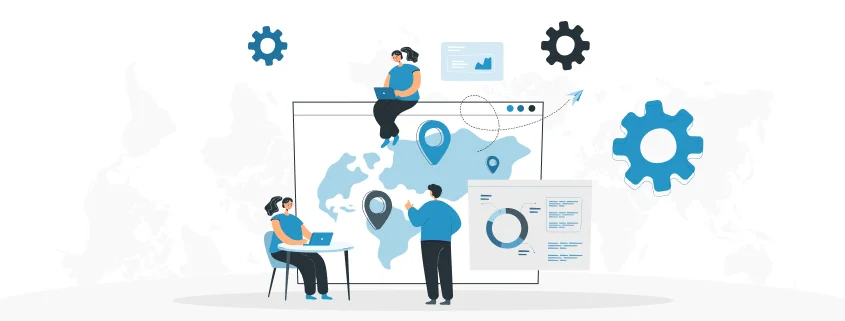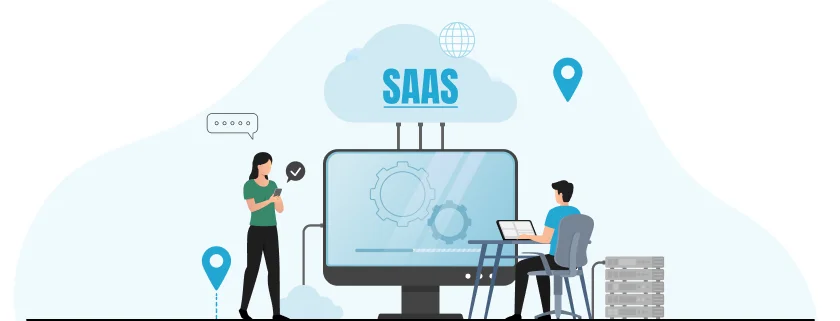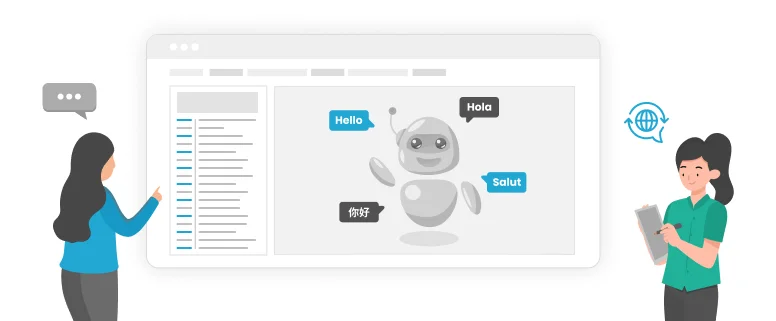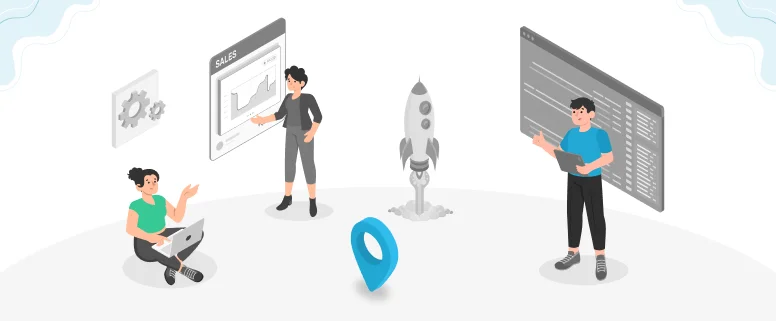One of the key advantages of technology is that people can offer their software as a service to others. Companies like Microsoft and Airbnb have made millions to billions of dollars by globalizing their SAAS products. One of the critical factors for their success was how easily they catered to the needs of different regions. Furthermore, companies adapt their software to other languages, cultures, and markets hoping to break into their economy.
Table of Content
- What is Software Localization?
- Types of Localization
- Importance of SaaS Localization for Business Expansion
- Things to Consider When Localizing SaaS
- Internationalization: A Prerequisite for Software Localization
- Software Translation and Software Localization: What’s the Difference?
- Popular Saas Companies that Have Localized to Expand
- Customer Relationship Management (CRM):
- Productivity and Collaboration:
- Project Management and Team Collaboration:
- Accounting and Finance:
- Human Resources and Talent Management:
- E-commerce and Online Retail:
- Marketing and Email Automation:
- Customer Support and Helpdesk:
- Content Management and Publishing:
- Video Conferencing and Webinars:
- Security and Identity Management:
- Cloud Storage and File Sharing:
- Backup and Disaster Recovery:
- Learning Management Systems (LMS):
- Healthcare and Medical Software:
- Real Estate and Property Management:
- Travel and Hospitality:
- Sales and Quote Management:
- Field Service and Maintenance:
- Video Conferencing and Webinars:
What is Software Localization?

Software localization is adapting your software into different languages according to cultural appropriateness and understanding. This may sometimes involve the UI and other software-related forms like websites, user manuals, marketing content, and more. Furthermore, when localizing software each region has its specific needs, and experienced professionals like in CCJK already know what formula works well.
Businesses now understand that the one-shoe-fits-all approach is dead. Brands are now more personal to the user’s needs. SaaS localization may be the key to unlocking different opportunities to grow your business. Furthermore, you may be surprised by the fact that 75% of consumers prefer to use software in their mother tongue. What an unbelievable number! You can ensure your software resonates directly with your target audience by working with a reputable localization company or hiring a qualified localization manager.
The process of localization involves translating language, cultural references, and user interface components. Moreover, this focus on detail improves customer satisfaction and accelerates the adoption of software in international markets. So localization of SaaS is beneficial for newcomers and seasoned professionals.
Types of Localization
- Converting the product language into the target audience language is Linguistic localization.
- Price localization is when users can buy the SaaS product in their country’s currency. Moreover, companies may offer different prices and plans for different regions.
- Payment system localization allows the user countries’ payment methods to be used to make payments.
- Cultural adaptation is making the software fit in with local cultural norms.
- Sometimes new features may be added that only cater to that specific audience.
- Software and Hardware customization to fit the needs of the technologies a certain region is accustomed to or has more of.
- Localization of videos, images, and content
- Website translations that include the SEO factors.
Importance of SaaS Localization for Business Expansion
The market is highly competitive, and the one-shoe-fits-all approach is no longer viable. People today prefer those who cater to their needs on a personal level. However, now it is all about who can do it better. Here are some ways in which localization helps users feel more connected to your SaaS.
1. Better User Experience Thanks to Language Adaption
The importance of language cannot be overstated for the success of any Software-as-a-Service (SaaS) company. Making SaaS products accessible in different languages allows these companies to improve the experience of their international users. Moreover, when users can use a SaaS platform in their language, it instills a sense of comfort and confidence. Ultimately, this improved user experience leads to higher adoption rates of the software and greater customer satisfaction.
Furthermore, localization involves more than just translation; it’s a comprehensive process that tailors the software to fit the cultural nuances and specific preferences of different countries. This includes:
- Adapting elements such as date formats
- Types of Currency
- Local measurement preferences
SaaS companies customize their interface and language to ensure that their global audience can find relatability and navigate their software with ease.
2. Expanding Reach
Expanding your business into international markets is a great way to ensure more opportunities. But this is easier said than done, venturing into a foreign market requires a deep understanding of that market’s culture and preferences. Furthermore, by utilizing localization services companies can align their services and content to meet the needs of the local population. Moreover, things like color schemes, aesthetics of design, and even the tone of content can help you establish a strong connection with your target audience.
For instance, a color that may carry a positive meaning in one region could carry the exact opposite meaning in another. Moreover, understanding these differences helps businesses stay in touch with their audience. Furthermore, utilizing local marketing strategies like region-specific promotions and collaborations with local influencers can help improve your brand’s visibility in those foreign markets. When SaaS companies approach localization strategically, they can extend their business in different regions with ease.
3. Being Competitive
Rapid growth in technology has ensured that competition between brands is not confined to any single geographical location. Furthermore, SaaS companies now prioritize localization as a form of investment to help them gain an edge over their rivals. When companies utilize SaaS localization, they gain a competitive edge over companies that overlook the importance of it.
When companies localize their SaaS products, they improve user experience and expand their reach. Moreover, it shows its consumers that the company is committed to serving and understanding the needs of its customer base. This ensures that consumers remain loyal and trust your brand more. Furthermore, when consumers see their needs be met, they are more likely not to look for alternatives.
“Businesses can’t afford to react to what their customers want; they need to anticipate their needs.” ~ Parker Harris, co-founder – Salesforce.
4. Customer Loyalty
When consumers see global products being marketed to them in their native language and in accordance with their culture. It fosters a sense of global unity, and more readily accepts you and your products. Furthermore, even those fluent in English, often prefer their native language. Hence, localizing software is not only about providing information but also showing respect to their audience. Moreover, this helps foster long-term relationships with them. Airbnb and Salesforce are good examples of this.
5. Increased Revenue
The main goal for most software companies localizing is increasing their revenue and expanding their business. Moreover, providing a personalized experience will definitely help companies achieve this goal. When you localize and translate software, you are automatically increasing your target audience size. In order to make a customer, they must first understand what your product is. Furthermore, after understanding your product they must also be able to affiliate with it. And this lastly translated into more sales and an increase in revenue.
When breaking into new markets and after completing localization. Moreover, if your customers enjoy your services will recommend it to others. Like the USA has Yelp, other countries also have similar platforms where your product is rated. Furthermore, carefully strategizing your localization strategy can help you achieve big goals.
Things to Consider When Localizing SaaS
Researching the market is crucial for localization. This process gives a deep insight into what your consumers expect from you. Moreover, consumer behavior varies greatly with the region. Things such as income, culture, technology, laws, language, education, and more play a role in determining consumer behavior.
After conducting your research you will have a better understanding of:
- Product demand in the market
- What features and functionalities are most important for users
- How the User Interface should be designed
- What prices are affordable and what price means maximum profit
- Who your competitors are
- Understanding the legalities of doing business
Since all SaaS products are unique, you will 100% learn more than what I have mentioned above. Let’s delve deeper into the topic, with some examples:
1. Adapting Content May Mean UI Changes
The most important thing about localization is getting a clear message across to the audience. However, not all languages have the same size of character and length. Furthermore, this often means adapting the UI to mimic a similar effect.
2. Payment System Localization
Let’s take the example of Fiver, Paypal is very commonly used to send payments from the US. But it is virtually unknown in China. Similarly, Poland has payment apps like Blik and Przelewy24, but credit cards are very rarely used there.
3. Product Feature Adaption
When launching software in Europe Databases are separately provided at an additional cost. But in the US people expect this to be an all-inclusive deal. Since competitors there, all offer an all-inclusive package for their SaaS. This is why we are often more likely to see price plans in US SaaS companies.
Internationalization: A Prerequisite for Software Localization
The process of internationalization entails having your software developed in anticipation of global expansion. Internationalizing software does not mean adding a language switcher in the UI but configuring the software to accept different forms of data while processing that data in local requirements. In lamen terms, this means that when a person from a specific region accesses your website, the software automatically fetches the right language chosen for that region. Moreover, instead of users having to manually view the list and change the language. Many users may not be able to understand how to switch the language.
Software companies that do not apply this proactive approach have expensive troubles later on. Software can be created for global expansion, regardless of the programming language it’s built on. Some of the most popular languages for this strategy entail
- Javascript localization
- React localization
- Angular localization
- Python localization
- Java localization
- PHP localization
- iOS localization
- Android localization
1. Software Internationalization Includes
1. Text Length
Languages have differences in length when explaining the same phenomenon. Hence, the development team should take this into consideration while creating spaces. Moreover, when creating changeable space, the maximum output should be expected.
2. UI Element Translation
Developers or software localization specialists can relocate all translatable material into a separate resource file while maintaining the original software code. As a result, translators can carry out localization tasks without modifying the source code.
3. Symbols & Numbers
Each language has its distinct way of formatting currency and numbers. Your software should be able to translate these with accuracy. Moreover, mistakes in this process can harm business’s reputation and your audience may feel distrust.
Direction of Language
Certain languages are written from right to left and some from left to right. For example, English is written from left to right, while Hindi/Urdu is written from right to left. Your software must understand such nuances.
- Other Such Changes
- Date and time
- Character Encoding
- Color Schemes
- Documentation
- Cultural Sensitivities
Software Translation and Software Localization: What’s the Difference?
Translation is one of the core processes of localization. It involves professional translators, preferably local speakers of your target language. That translates one language into another. Localization, on the other hand, is much more expansive. Furthermore, you can even say that translation is a part of the localization process. Moreover, localization includes adapting colors, dates, time formats, images, content, and often UI features to make the software look as native as possible.
Localization can often include manipulation or changing the content completely so as to keep the original meaning intact. Furthermore, after all changes are made they must also be thoroughly tested to ensure that the software works properly.
1. Ensuring Legality and Cultural Sensitivities
Your software is also audited for finding any cultural sensitivity breaches or cultural taboos. Moreover, its documentation or services may also be adjusted to remain within legal limits or business regulations. Moreover, legality issues can include disclaimer texts, privacy laws, censorship laws, tax information, and more. The main purpose is to avoid any fines, backlash, and reputation damages.
Popular Saas Companies that Have Localized to Expand
Software as a Service (SaaS) products encompass a wide range of applications and services delivered over the Internet. Here are a few examples of well-known SaaS products across different industries:
1. Customer Relationship Management (CRM):
- Salesforce
- HubSpot CRM
- Zoho CRM
2. Productivity and Collaboration:
- Microsoft 365 (formerly Office 365)
- Google Workspace (formerly G Suite)
- Slack
3. Project Management and Team Collaboration:
- Asana
- Trello
- Monday.com
4. Accounting and Finance:
- QuickBooks Online
- Xero
- FreshBooks
5. Human Resources and Talent Management:
- BambooHR
- Workday
- Zenefits
6. E-commerce and Online Retail:
- Shopify
- BigCommerce
- WooCommerce (for WordPress)
7. Marketing and Email Automation:
- Mailchimp
- HubSpot Marketing Hub
- Marketo (Adobe)
8. Customer Support and Helpdesk:
- Zendesk
- Freshdesk
- Intercom
9. Analytics and Business Intelligence:
- Tableau
- Google Analytics
- Mixpanel
10. Content Management and Publishing:
- WordPress
- Drupal
- Wix
11. Video Conferencing and Webinars:
- Zoom
- Webex (Cisco)
- GoToMeeting
12. Security and Identity Management:
- Okta
- LastPass
- Duo Security (Cisco)
13. Cloud Storage and File Sharing:
- Dropbox
- Box
- OneDrive (Microsoft)
14. Backup and Disaster Recovery:
- Carbonite
- Acronis
- Backblaze
15. Learning Management Systems (LMS):
- Moodle
- Canvas (Instructure)
- Blackboard
16. Healthcare and Medical Software:
- Athenahealth
- Cerner
- Epic Systems
17. Real Estate and Property Management:
- AppFolio
- Buildium
- Yardi Voyager
18. Travel and Hospitality:
- Airbnb
- Expedia Partner Solutions
- Booking.com for Business
19. Sales and Quote Management:
- Configure-Price-Quote (CPQ) tools like Salesforce CPQ
- PandaDoc
- Proposify
20. Field Service and Maintenance:
- ServiceNow
- FieldEdge
- Housecall Pro
Conclusion
As you might have understood, localization is a very important process and can potentially open up many new markets for you. Our team of professionals, not only understands this but has successfully helped many SaaS companies establish firm holdings in different regions. Furthermore, all common household-named SaaS products have implemented carefully planned localization methods. Moreover, reading the case study of any of the mentioned companies will help you understand its importance.



